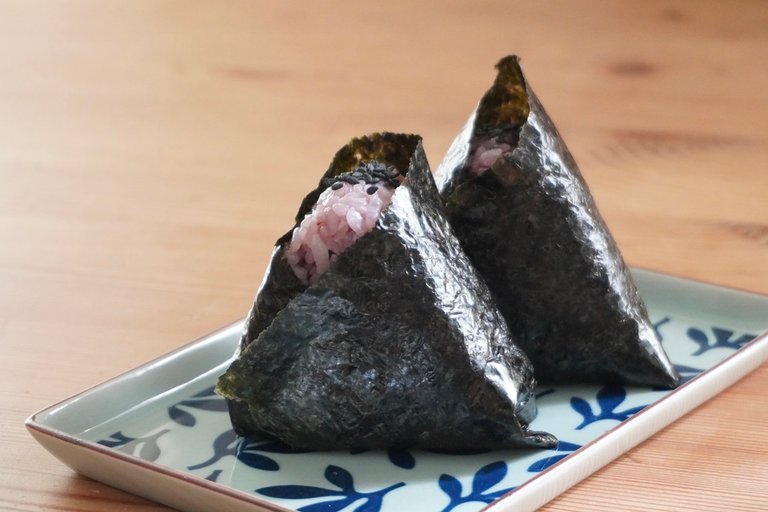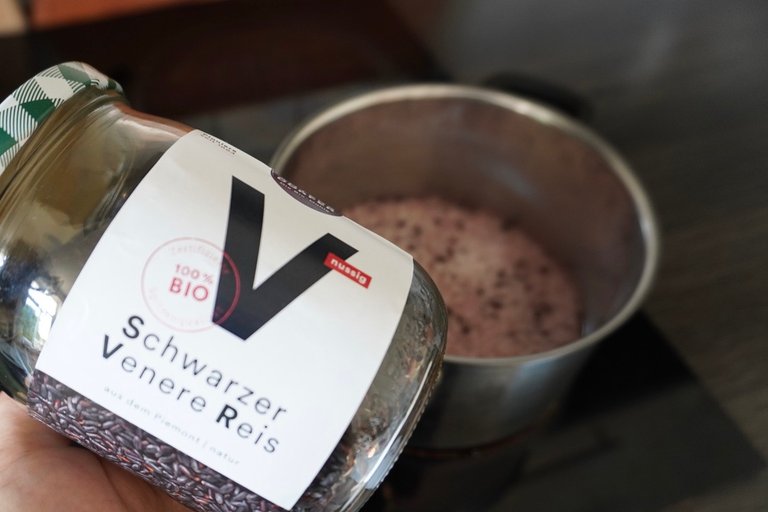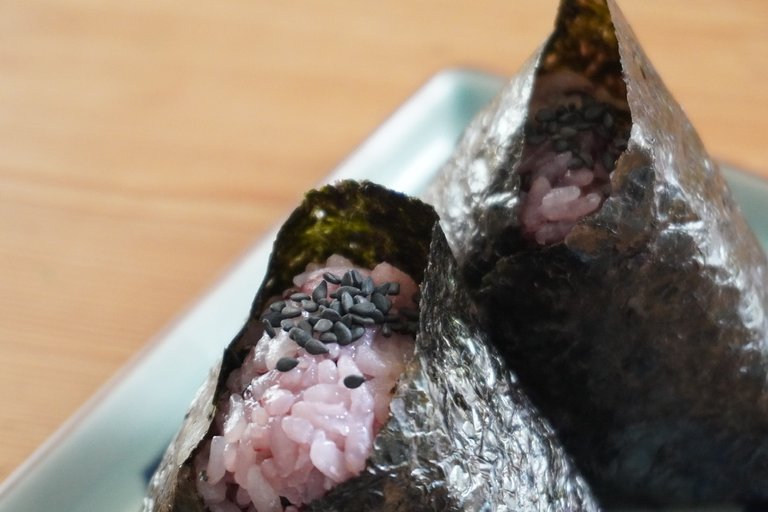
My daughter occasionally requests plain salted Onigiri (rice balls). While they are simple and perfect way to enjoy the taste of rice and seaweed, I wanted to add a little twist, so I thought about making it with mixed grains.
I had learned about ”Job's tears” (a sort of barley) has great health benefit and wanted to try it, but unlike in Japan it seems that it is not easily available in Germany. Both my daughter and I enjoy the texture of barley, and while I was considering using the barley or millet we had in the kitchen, I spotted Italian black rice at an organic shop and decided to make salt Onigiri with black rice instead.

I asked ChatGPT about black rice and learnt that black rice is a type of ancient rice with a black-purple hue, rich in nutrients, especially anthocyanins. This gentle black-purple color also looks great in sushi rolls.
Cooking black rice is simple. The black rice I used takes a bit longer to absorb water, so I soaked it for about an hour with regular Japanese rice. I added one tablespoon of black rice to one cup (180ml) of regular rice and cooked it with 200ml water (the water ratio remained the same as usual). Start cooking on low heat, then turn higher, and once the water has evaporated, turn off the heat, mix gently with a rice paddle, and let it steam for a while with the lid on.
Once it cools down to a manageable temperature, I use the wooden rice ball mold I designed and produce to make four 90g rice balls. After removing them from the mold, I dampen my hands, sprinkle salt, and shape Onigiri. I wrapped them in seaweed and added some black sesame seeds on top for an extra touch of black.

When making simple salt Onigiri, adding a bit more salt enhances the flavor of the rice and grains. The presence of grains makes you chew more, which might also enhance the flavor.
A small, simple rice ball with 90g of rice has about 140kcal each. My partner has started dieting, and I found myself checking the calories more often. Two to three rice balls with miso soup make a satisfying meal of just over 500kcal.
The savory taste of the grains with a hint of salt makes these Onigiri easy to eat, even on hot summer days when you might not have much of an appetite. If you come across black rice, why not give this Onigiri a try?
Happy Onigiri making, everyone!
Four Seasons Onigiri Series.
- #1 Classic Umeboshi Onigiri
- #2 Green pea onigiri
- #3 Simpe Salt Onigiri with Black Rice

子供が時々何も入れない塩むすびをリクエストしてきます。潔くて良いけれど、何かひとひねり加えたくて、雑穀ご飯の塩にぎりはどうだろうと思いつきました。
食養生などの文脈で知ったハトムギを使ってみたかったのですが、どうやらハトムギはドイツでは簡単に手に入らないようで断念。私も子供も大麦のプチプチ感が好きで、台所にストックのある大麦やヒエもいいかなと思いつつ、オーガニックショップで雑穀を眺めていると、イタリア産の黒米が目について、黒米で塩むすびを作ることにしました。

この投稿を書きながら、「黒米」は「くろごめ」と読むことを知りました。「くろまい」ではうまく漢字変換できず、ChatGPTにどう読むのか尋ねてみたのです。ついでに「黒米は黒紫色をした古代米の一種で、栄養価が高く、特にアントシアニンが豊富」ということも教えてくれました。色が楽しいだけでなく、なんだか体に良さそうです 😉 そうそう、このやさしい黒紫色は、太巻きに使っても映えますよ!
黒米の炊き方はシンプルです。私が使った黒米は吸水に少し時間がかかるので1時間ほど長めに浸水させて、お米1合に黒米大さじを加えて炊きます。水加減はそのままのお米1合180mlカップ1杯に対して200mlで大丈夫でした。はじめちょろちょろ中ぱっぱで炊いて、水気がなくなる頃に火を止めて、しゃもじでやさしく混ぜて、また蓋をしてしばらく蒸らします。
いい加減に冷めたらおにぎり型を使ってひとつ90gくらいのおにぎりを4つ作ります。型から出したら水気のある手に塩を少し多めにまぶして、その手でおにぎりの形を整えます。海苔をまいて出来上がり。黒黒した感じがよかったので黒ごまを上部にまぶしてさらに黒を追加してみました。

シンプルな塩むすびはちょっと塩をきつめにすると、お米や雑穀の味わいが引き立ちます。雑穀が入っていると心なしかよく噛むのも穀物の味わいを引き立てるのかもしれません。
ごはん90gの小さいシンプルなおにぎりのカロリーはひとつあたり140kcalほど。相方がダイエットをし始め、私も久しぶりにちょいちょいうろおぼえのカロリーをチェックしてみているのでした。おにぎり2−3つとお味噌汁で500kcalちょっとの立派な一食になります。
雑穀の味わいに塩味がキリッときいて、食欲が少なめの夏の暑い日でも食べやすいと思います。黒米をみかけたら黒米の塩むすび、作ってみませんか。
四季のおにぎりシリーズ
- #1 ド定番の梅干しおにぎり
- #2 グリーンピースおにぎり
- #3 黒米塩むすび
